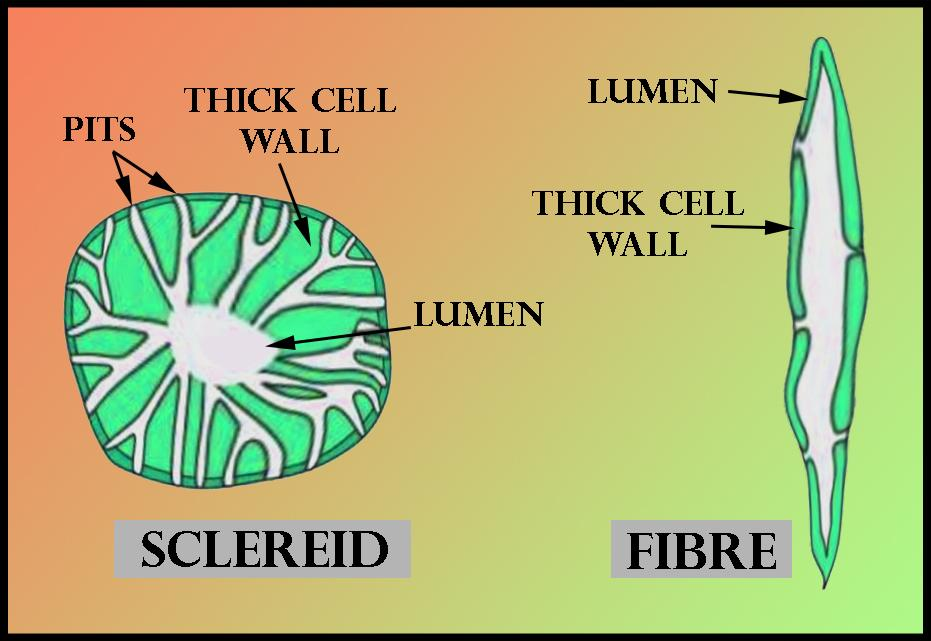
Sclereids or stone cells are modified form of
(a)Collenchyma
(b)Sclerenchyma
(C)Fibers
(d)Xylem vessels
Answer
479.7k+ views
Hint: They are thick and lignified tissues that make the plants hard and stiff, and provide additional support, rigidity, and strength to the plant body. They are dead tissues lacking in protoplasm, and are elongated and pointed at both the ends.
Complete answer:
Sclereids or stone cells are a reduced form of the sclerenchyma cells. They are highly thickened and lignified cellular walls that form small bundles of durable layers of tissue in most plants. They often occur singly or in small groups and give rise to a granular texture in fruits, for example, pears. It is also known as a stone cell. Sclereids are typically found in the epidermis, ground tissues, and vascular tissues. Its primary function is to provide strength or support to soft ground tissues. They are extremely variable in shape and are present in various tissues of the plant, such as the periderm, cortex, pith, xylem, and phloem.
Additional Information: -Collenchyma cells tend to have very thin primary walls along with some areas of secondary thickening. It provides extra mechanical and structural support, particularly to new shoots.
-Plant fibers are generally composed of cellulose in combination with lignin, such as cotton, hemp, jute, and flax.
-The xylem vessels are long tubes that help in the transportation of water and provide mechanical support. Each xylem vessel is formed by the end to end union of a large number of short, wide, lignified dead cells. In these cells both the nucleus and cytoplasm are absent.
So, the correct answer is, ‘ Sclerenchyma’.
Note: -The stone cells differ from the fiber cells by not being immensely elongated.
-It is the presence of numerous sclereids that form the cores of apples and produce the grainy texture of guavas.
-They are also present in leaves and fruits and also constitute the hard shell of nuts.

Complete answer:
Sclereids or stone cells are a reduced form of the sclerenchyma cells. They are highly thickened and lignified cellular walls that form small bundles of durable layers of tissue in most plants. They often occur singly or in small groups and give rise to a granular texture in fruits, for example, pears. It is also known as a stone cell. Sclereids are typically found in the epidermis, ground tissues, and vascular tissues. Its primary function is to provide strength or support to soft ground tissues. They are extremely variable in shape and are present in various tissues of the plant, such as the periderm, cortex, pith, xylem, and phloem.
Additional Information: -Collenchyma cells tend to have very thin primary walls along with some areas of secondary thickening. It provides extra mechanical and structural support, particularly to new shoots.
-Plant fibers are generally composed of cellulose in combination with lignin, such as cotton, hemp, jute, and flax.
-The xylem vessels are long tubes that help in the transportation of water and provide mechanical support. Each xylem vessel is formed by the end to end union of a large number of short, wide, lignified dead cells. In these cells both the nucleus and cytoplasm are absent.
So, the correct answer is, ‘ Sclerenchyma’.
Note: -The stone cells differ from the fiber cells by not being immensely elongated.
-It is the presence of numerous sclereids that form the cores of apples and produce the grainy texture of guavas.
-They are also present in leaves and fruits and also constitute the hard shell of nuts.

Recently Updated Pages
Master Class 11 Economics: Engaging Questions & Answers for Success

Master Class 11 Business Studies: Engaging Questions & Answers for Success

Master Class 11 Accountancy: Engaging Questions & Answers for Success

Master Class 11 English: Engaging Questions & Answers for Success

Master Class 11 Computer Science: Engaging Questions & Answers for Success

Master Class 11 Maths: Engaging Questions & Answers for Success

Trending doubts
Which one is a true fish A Jellyfish B Starfish C Dogfish class 11 biology CBSE

State and prove Bernoullis theorem class 11 physics CBSE

1 ton equals to A 100 kg B 1000 kg C 10 kg D 10000 class 11 physics CBSE

In which part of the body the blood is purified oxygenation class 11 biology CBSE

One Metric ton is equal to kg A 10000 B 1000 C 100 class 11 physics CBSE

Difference Between Prokaryotic Cells and Eukaryotic Cells




